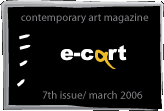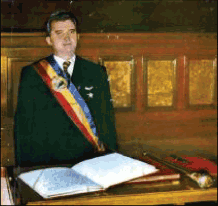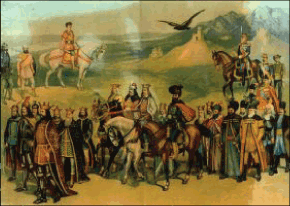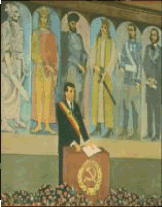EPOCA
DE AUR - THE GOLDEN ERA
Portrait of a Dictator
"The Nicolae Ceausescu era is inscribed in the chronicle of Romanian history as the epoch of the most grandiose constructive work undertaken by the Romanian people. The great accomplishments of the 1965-1985 decades were obtained under the leadership of the party, having in front its general secretary, comrade Nicolae Ceausescu, the hero among heroes who has inscribed his name in the gallery of the great founders of country and history, the prominent personality by which the Romanian genius makes its mark on the contemporary universal spirituality. The enormous capacity to create of the Romanian people, its unmoveable will to continue on the road of the new world order, have found their full expression in the construction of the socialist multilaterally developed society on our ancestral lands.
Many and great industrial objectives, results of the policy of economical rebirth of Romania, are adorning all the counties in these two decades since the 9th congress of the Romanian Communist Party (PCR). Strongly united around the general secretary of the Party, the President of the Republic, comrade Nicolae Ceausescu, the Romanian people thus brings out fully the value of its creative energies, affirming its desire to live free, in peace and cooperation with all other peoples of the world."
Portrait of a Dictator
"The Nicolae Ceausescu era is inscribed in the chronicle of Romanian history as the epoch of the most grandiose constructive work undertaken by the Romanian people. The great accomplishments of the 1965-1985 decades were obtained under the leadership of the party, having in front its general secretary, comrade Nicolae Ceausescu, the hero among heroes who has inscribed his name in the gallery of the great founders of country and history, the prominent personality by which the Romanian genius makes its mark on the contemporary universal spirituality. The enormous capacity to create of the Romanian people, its unmoveable will to continue on the road of the new world order, have found their full expression in the construction of the socialist multilaterally developed society on our ancestral lands.
Many and great industrial objectives, results of the policy of economical rebirth of Romania, are adorning all the counties in these two decades since the 9th congress of the Romanian Communist Party (PCR). Strongly united around the general secretary of the Party, the President of the Republic, comrade Nicolae Ceausescu, the Romanian people thus brings out fully the value of its creative energies, affirming its desire to live free, in peace and cooperation with all other peoples of the world."
* * * * *
The horribly contorted phrase opening this paper has appeared as a caption to the covers of the Magazin Istoric, the Romanian history monthly magazine, in July 1985. The personality cult of Romania's own Great Leader had already reached its peak by now, and it continued to use this bombastic and megalomaniac phraseology, up to the very end of the Ceausescu dictatorship, on 21 December 1989. That evening, following the news (the Telejurnal) presenting Ceausescu's mighty words, while in Bucharest and elsewhere the people were being shot at by the oppressive apparatus, the only TV station in the land was blearing patriotic songs and poetry recitals, all in the same vein as the text above. The following day, the 22nd, by the afternoon, the same TV station was emitting live from the street in front of its main studios what would be known as the Romanian Revolution of 1989 and, also, the first televised event of this type.
It is not the goal of this work to speak about the Revolution (or orchestrated coup), but, to employ a phrase of the time, about the revolutionary creativity of the Romanian people, especially when dealing with the representation in image of its mighty Conducator and his wife, the Romanian universal mother.
It is our opinion that what you are about to see was not the work of the dictator, nor of some Party apparatchik, but a complete iconographic programme that was meant to rival and surpass those of the historical figures from the Romanian pantheon.
We are going to trace, as far as our powers permit, the birth of an unfortunate and undesired icon, or rather of a spectre that haunted Romania for about 20 years.
A personality cult and personal iconography is nothing unusual in the 20th century, for, as we know, leaders of the first five decades have benefited from it: Mussolini, Hitler, Lenin, and Stalin (and through Soviet propaganda, Karl Marx and Friedrich Engels, although long time dead). We are not taking in the account, obviously, the state imagery of ruling monarchs, inasmuch as it is not connected to a dictatorial tendency.
This is the case of Carol II of Romania, known for his royal dictatorship, who wanted to project a powerful image to his subjects, besides the usual official images all other monarchs of the time enjoyed. In pre-1945 Romania, the personality cult was not only the appendage of the monarch. There also was a well established cult of the chief of the Legionari , 'Captain' Corneliu Zelea Codreanu, and later on of Marshall Antonescu , who was also the first to assume the title of Conducator, some 40 years before Nicolae Ceausescu. Nevertheless, we think that Codreanu and Antonescu are not an influence on Ceausescu's imagery, whereas we believe that Carol's iconography and even some ideas were heavily relied upon for inspiration.
To this, we have to add the cult of the Heroes of the Nation, which has emerged towards 1830s and was duly propagated by all Romanian revolutionaries and fighters for Romanian state independence, unity and progress from that time onward. The images invoked by these luminaries of the 19th century are those of princes from the past, staring with Mircea cel Batran (Mircea the Elder, reigned 1386 - 1418), going through the 15th century to Vlad Tepes (Vlad the Impaler, 1431 - 1476) and Stefan cel Mare (Stephen the Great, 1433 - 1504), then to Mihai Viteazul (Michael the Great, reigned 1593-1600) and ending with Constantin Brancoveanu (1688-1714).
These figures were already deeply rooted in the national consciousness, even from their lifetime, by ballads and legends, but the national rebirth of the 19th century has put them back into the spotlight. The reason is simple: they were meant to remind the contemporary Romanians the fight for freedom - all princes mentioned above fought the Ottoman Turks and strove to keep some independence to their countries. Of course, as the 20th century dawned, the revolutionary figures of the 19th century, the engineers of the Romanian national revival and Romanian national unity, were added to the national Pantheon.
To those observing history, digging for lost connections to those who once ruled, or inventing them, when there are none, is nothing new - all power transfers have had to make appeal, to a greater or lesser extent, to an earlier authority which would lend importance and, above all, give a justification, and more so when the new establishment has precious little in common with those figures of the past.
In Romanian history, the cases are too many to enumerate. I will mention, nevertheless, Neagoe Basarab (reigned 1512 - 1521), who rose to the dignity of Voivode by calculated machinations and wise alliances. As in Western Europe, the Orthodox East also had the tradition of presenting the important donors of a church or artefact and, in the churches he founded, more specifically at the beautiful Curtea de Arges monastery, Neagoe was depicted with his wife, sons and daughters, and a whole procession of ruling ancestors, including two canonised forefathers of his Serbian wife, Despina Brankovic.
It is interesting to see that later Voivodes take their model of establishing blood connections with the throne (a prerequisite was to have been one of 'os domnesc' - literally meaning kingly bones) by depicting 'good' ancestors and omitting - or even erasing from already existent paintings - the 'bad' ones. This line is, nevertheless, broken with the arrival of Greek princes appointed by the Ottoman Sultan to the thrones of the Romanian principalities (1711 - 1821). There are some notable examples of 'Romanianised' Greek princes, such as the Mavrocordat and the Ghica family, but they do not enter in this discussion. Alexandru Ioan Cuza, the first ruler of the State of Romania (reigned 1859 - 1864) did not insist too much on his image being connected to those of his predecessors, nor did Carol I (1866 - 1914). At least, not explicitly. Carol, for a change, preferred to connect with Romania's past by renovating the churches of the princes of old, both in Walachia and in Moldavia. He even settled on Curtea de Arges as a royal necropolis. The irony is that the church was meant to be a necropolis, but for Neagoe Basarab and his heirs, more than 300 years before Carol's time.
Nevertheless, we are in possession of an image which recalls all the worthies of national history, starting with Emperor Trajan and King Decebalus, which we are going to discuss further on.
Ferdinand (1914 - 1927), Carol's heir, did not need to make appeal to past history, being distinguished by the non-alignment to Austria and Germany in World War I, despite his being a Hohenzollern, and by the complete unification of Romania after the war, in 1918, which earned him de sobriquets 'The Loyal' and 'The Unifier'.
The story is different in what regards his son, Carol II (1930 - 1940), whose reputation as a playboy was notorious, leading to him being forced by his father to renounce the throne, in 1925, in favour of his under-age son, the future King Michael (born 1921, reigned 1927 - 1930, and 1940 - 1947). At his return in 1930, Carol II starts an image campaign, leaning both on historical models and on modern ones, some nationalistic, some of Italian fascist inspiration. One of the first things he did in order to impress the general public, and to assert his Romanian-ness, was to create his son as Great Voivode of Alba Iulia - the title recalling Michael the Brave, the prince who had unified in 1600, for political purposes, Walachia, Transylvania and Moldavia. That union lasted only one year, but the impact on later public consciousness was strong.
The royal dictatorship of Carol II will bring the Front for National Resurrection, nominally the king's own party, which will be declared, be decree, some months before Carol's abdication, the sole, authoritarian party of the country, called henceforth the Nation's Party. The communists after 1947 will do exactly the same thing, decreeing the Romanian Communist Party the only allowed party, the State's party. Later on, Ceausescu will echo not the actions, but the nationalist propaganda and the methods of the king's personality cult. Of course, there is an element which should not be oversight: that is the influence of the personality cult of the Greatest Leader of them all, Chairman Mao, and possibly that of the other luminary of the Far East, Kim Il Sung, both bosom friends of Nicolae Ceausescu. Romanian popular belief, based on the changes in social and economic life, has it that these influences came out after Ceausescu's great tour of China and North Korea, in the early 1970s. And when we look at the state imagery of Ceausescu starting with this period, we cannot but agree with this thesis.
We will not bother the reader with many other old Romanian historical facts in the following. But before going any further, we feel that we need to start in earnest by quoting the actual words on art uttered by Romania's Most Beloved Son:
"We believe that the duty of writers and artists is to actively contribute to the making of the new man, to the forming of the socialist conscience, to the development of socialist humanism, and of those moral virtues we wish to cultivate in each citizen, and which the Romanian people has in its psychological structure".
* * * * * * * *
The control over the actual image of the Great Leader was strict. The images, photographs or paintings, were scrutinised for blemishes or angles that would show an unfortunate foreshortening.
The following is a bit of legend, but in a country where jokes featuring the president's family were dangerous and could land the joker for a night in a cold cell, we should not be surprise if this is how things happened. The standard state image of Nicolae Ceausescu, until 1986-8, the image appearing on official portraits placed in schools and state institutions of all kind, showed a 50-60 something man, his hair a little strewn with grey, in a three-quarters profile, smiling benignantly. There was no flaw at all in this until the time that some person with a sense of humour called this type of portrait 'Ceausescu intr-o ureche' (One-eared Ceausescu). There is nothing inherently wrong with one's picture showing one ear only and there is not something of a cultural taboo to be a one-eared person. But, in colloquial Romanian 'A fi intr-o ureche' means 'being a bit mad' - so the state portrait changed accordingly to a semi-frontal portrait that clearly shows the other ear.
Still, the joke doesn't finish here. If we should
categorise the imagery of the former dictator, we can speak about several
types of image:
" The state image / portrait - Ceausescu by himself
" The state image / portrait - the presidential couple
" Ceausescu (by himself and with his wife) and the people
" Ceausescu (by himself and with his wife), the people, and the
accomplishments of the 'Nicolae Ceausescu Epoch' (hydro-electrical centrals,
factories, etc)
" Ceausescu (by himself and with his wife) and the children of
Romania
" Ceausescu and the heroes of the nation
To all these we can add a private dimension, there being numerous examples of the categories above that were meant as a personal homage to the dictator, never to be shown in public galleries, museums or institutions. They are images that go from showing Ceausescu's great passion for hunting to the incredibly ludicrous image of the great Voivode Stefan cel Mare toasting the presidential couple from a painting, in a manner that can't be considered anything but cartoonish. It is clear that this painting by Dan Hatmanu, one of the foremost painters in the land, was meant as a birthday card - near the living portrait of the Voivode, a calendar shows the date - January (Ceausescu's birthday was 26 January).
For Romanians of the younger generation and for Westerners this might appear at least strange, but starting with the late 1970s, the dictator's birthday had become an unofficial national holiday , when all the country was officially overexerting itself in sending congratulatory telegrams and gifts, and the state TV and radio presented anniversary shows (patriotic poetry and songs, some of which will be presented later on).
We can characterise some of the private gifts completely over the top, as the painting above clearly shows. Besides the occasion with which it was given, the painting above, and many others like it, presents a mystery: did someone order it or was it a personal gift of the painter? Writers, artists and musicians of the time were all striving to be taken into consideration by the Communist Party and its Leader. Presenting works that praise them could have extremely beneficent consequences, such as state orders for murals, official paintings, the publication of books, the chiefdom of some Artists', Writers' or Composers' Union's office, freedom to travel and so on.
Getting the State's (i.e. Ceausescu's) patronage was the Holy Grail: some of the fortunes and connections made then are still very well in place nowadays. Some artists have admitted to this type of favouritism, but in the light of 'they were orders placed by the County Council'. The can of worms was opened for the first time (and closed shortly thereafter) when Bucharest's Museum of Contemporary Arts mounted the so-called 'Paintings' Museum' (Muzeul de pictura), curated by Floe Tudor, in March 2005. The show displayed some 150 paintings of all sorts and sizes representing the dictator and his wife, as well as other encomiastic images. The majority of the paintings were made by esteemed members of the Academia, presidents of Artists' Unions...
"Not one of [the artists] has painted these works against their will; they all felt they had to pay a tribute. They all had good positions in the guild: none of them is a second rank artist. No, they were among the respected ones, people who thus defended their spot in the guild hierarchy and in the cultural hierarchy of the time", punctuates the Romanian art critic and publicist, Tudor Octavian. The consolidation of the professional and social position was doubled, through these compromises, by important material gains. Those were the times when a poem about the 'comrades' and 'the golden epoch', published in a homage volume, was paid with 3000 de lei apiece [...]. In the world of fine arts, paintings with Ceausescu were going with up to 100,000 lei, at the time when a Dacia car was 70,000. "Not under any circumstances such a painting was sold with less than 40-50,000 lei. It was a vicious circle. If one would sell or buy cheaper, there was the risk of open interpretation", says Tudor Octavian.
The attitudes of the artists concerned in this embarrassing situation were generally relaxed. The author of the toasting Voivode, Dan Hatmanu, affirmed in a newspaper that "I had no idea of this exhibition. [..] All the works were ordered by the County Party Committee. Some people received money for them. In all these, the artist was only doing his job. When he had to, he did it. Regarding the Stefan cel Mare painting, I had problems arising from it. It was interpreted as an irony regarding Ceausescu, and it was commented on Radio Free Europe . I was even taken in for questioning by the Securitate . Creating this work, the irony was subconscious" .
This present work does not point a finger at anyone, but allow us to take this excuse with a pinch of salt. But here is another artist, being frank and shedding some light on the matter:
"I consider that all I did is artistically valid. I worked for the money. Some works were bespoke orders, some were bought later on. [...] If you want to make money - that's fine, if not, nobody forces you. That the portrait was Ceausescu's, it matters little to me. It could have been the Pope's. I did my job as well as a worker in a factory. It was a well paid job".
But the mystery remains: were the artists completely blameless in creating Ceausescu's iconography?
* * * * * * *
And, since we are talking about the unofficial state holiday of 26 January, here is an excerpt of the page 1 of Magazin Istoric, nr. 1 (250) January 1988 that literally speaks volumes:
<< We have inherited from our forefathers
the custom of honouring our leaders, the great country-builders who,
by their deed and thought, have bestowed and are bestowing excellence
on the deeds and thoughts of the people.
We remember with emotion and gratification the epochs that remind us
the great Boerebistas and the fearless Decebalus, Mircea, Stefan, [Vlad]Tepes,
Michael the Brave, Brancoveanu and Alexandru Ioan Cuza, all the great
men of the nation who have proved their love of the people, and have
identified with its will and aspirations.
[...] Personifying as no-one else before in our past "the will and thought of the people", the general secretary of the party, this country's president, is presented before History as a brilliant builder of civilization and New Country, hero among the heroes of the Nation, fierce patriot and continuous revolutionary, thinker of genius, political man of worldwide renown. An exceptional age, an age of great realisations, the age we are living has rightfully entered history named after it hero, The Nicolae Ceausescu Era.>>
We hope that this presentation has managed to give some idea of the background in which the cult of Ceausescu was born and thrived. We are going to speak more of the embodiment in image and other forms of this cult, in the second part of the study, soon.
 |
|
|
||||||||||||||||||
 |
 |
 |
|
|||||||||||||||||
| |
|
|||||||||||||||||||
 |
|
|
|
|||||||||||||||||
| |
|
|||||||||||||||||||
 |
|
|||||||||||||||||||
 |
 |
|
 |
 |
|
|||||||||||||||
| |
 |
|
|
|||||||||||||||||
| |
|
|
|
|||||||||||||||||
| |
|
|
|
|
|
|||||||||||||||
| |
|
|||||||||||||||||||
| |
|
|||||||||||||||||||
| |
|
|
||||||||||||||||||
 |
|
|||||||||||||||||||
| |
|
|
||||||||||||||||||
 |
|
 |
|
|||||||||||||||||
 |
|
|||||||||||||||||||
| |
|
|||||||||||||||||||
| |
|
|||||||||||||||||||
| |
|
|
|
|
|
|
|
|
|
|
|
|
|
|
|
|
|
|
|
|